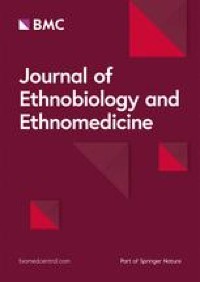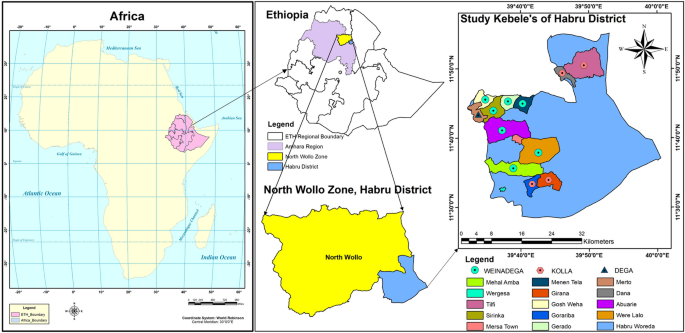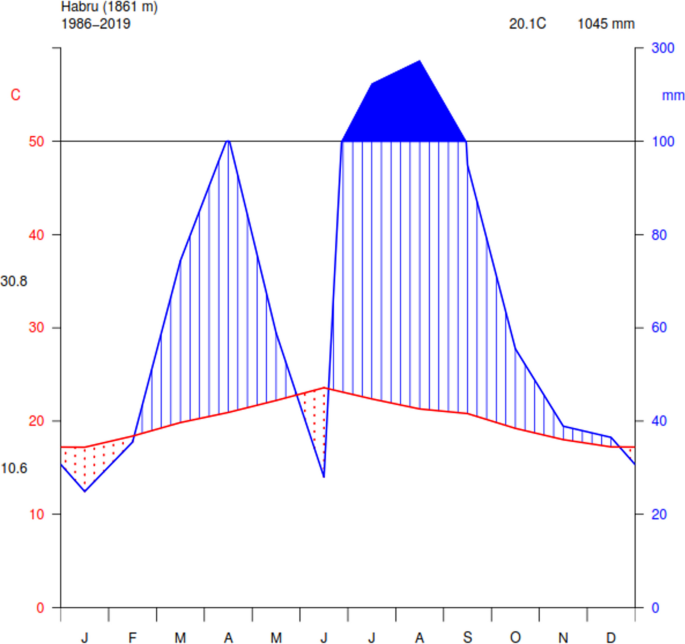Description of the study area
The study focuses on the ethnobotany of medicinal plants in the Habru District, situated in the North Wollo Zone of the Amhara Region, Ethiopia (Fig. 1). Habru District has 36 rural kebeles (subdistricts) and three urban administrations, with a total area of 1350.4322 km2. According to the Habru District Agriculture and Rural Development Office 2019 report, Mersa town is the center of the District, which is 88 km north of Dessie town and 491 km north of Addis Ababa, the Ethiopian capital, 406 km west of Bahirdar (Amhara Region’s capital), 30 km northeast of Woldiya (North Wollo Zone capital) [30]. The grid references for Harbu District come within 11°35′0″–11°55′0″ N and 39°30′10″–40°10′0″ E with an altitudinal range of 1430–2800 masl. It is bordered to the south by the Mille River, separating it from the South Wollo Zone. To the west lies Gubalafto District, while the Alawuha River forms the northern boundary, separating North Wollo from Kobo woreda. The eastern border is defined by the Afar Region. The weather condition of Habru District is characterized by the cold climate which is locally known as dega (temperate) and covers 3.5% of the total area of the district, the warmest, which is locally known as kolla (tropical) and covers 56.5% and medium, which is locally known as weinadega (subtropical) and covers 40% [30]. Rainfall data from 1986 to 2019 were obtained from the Ethiopian National Meteorology Agency (ENMA) Sirinka station, the mean annual temperature of the study area is 20.1 °C (Fig. 2). This corresponds to the monthly minimum and maximum temperatures of 10.6 °C and 30.8 °C, respectively [31]. Habru District has a population of 192,742, with a majority residing in rural areas [30]. The population density is 155.46 persons per square kilometer, higher than the zone average. The inhabitants mainly practice Muslim (76.85%) and Ethiopian Orthodox Christianity (22.95%) [30]. The economic activities in Habru District are centered around large commercial farms focused on livestock rearing and agro-processing, particularly in the Girana kebele. The district benefits from market access facilitated by the main road connecting it to Addis Ababa, and local products are sold in nearby markets such as Mersa and Dessie town.
Reconnaissance survey and site selection
Before the commencement of the reconnaissance survey, an official letter was received from the Department of Plant Biology and Biodiversity Management (DPBBM) at Addis Ababa University. Additionally, verbal informed consent was obtained from each participant involved in the study during the designated period. The reconnaissance survey took place between June 14, 2021, and July 02, 2021, within the confines of Habru District. Its purpose was to develop an initial understanding of the agro-ecological characteristics of the region, the prevailing vegetation status, the local population’s indigenous knowledge regarding plant applications for various uses, and an assessment of accessibility and other pertinent environmental conditions. To select study kebeles, the purposive sampling method was employed, with a focus on identifying kebeles with better vegetation cover and a well-known history of utilizing medicinal plants. These kebeles were also deemed potential sites for home gardening activities. In addition, the selection of study sites was underpinned by prior insights gathered from participants in focus group discussions (FGDs), community leaders, venerable elders, traditional healers, and healthcare personnel within the locality. As a result, a total of 13 study kebeles were chosen, representing 35% of the entire kebele count within Habru District. These selected study kebeles are enumerated as follows: Worgesa, Gosh Weha, Sirinka, Gerado, Girana, Dana, Abuarie, Tilfi, Menen Tela, Merto, Gorariba, Mehal Amba, and Were Lalo.
Sample size determination and selection of informants
The determination of the informant sample size adhered to the methodology outlined in [32] as cited in [33]. Accordingly, the sample size (n) was calculated using the formula:
$$n = \frac{N}{{1 + N \left( e \right)^{2} }}$$
where n = sample size to be used for this research, N = total number of households (HH) in all subdistricts, e = maximum variability or margin of error 5% (0.05), 1 = the probability of the event occurring. To establish the number of households to be interviewed within each kebele, the following formula was applied:
$$A = \frac{B \times n}{N}$$
where A = sample size to be used in a given kebele, B = total number of households (HH) found in a given kebele, n = total sample size to be used for this research, and N = total number of households (HH) in all subdistricts.
The research encompassed a total of 388 informants (250 males and 138 females) from all 13 kebeles within Habru District (Table 1). The selection of these informants followed systematic random and purposive sampling methods, including peer recommendations, as described by [34]. Nominations of traditional herbalists to participate as key respondents were collected from community members, elderly people and knowledgeable inhabitants as the methods recommended by [35, 36] and used to identify 42 key informants (34 men and 8 women) among the inhabitants, whereas general informants were systematically sampled during random visits made to houses in the study kebeles.
Data collection
The ethnobotanical data collection encompassed three distinct field trips carried out between June 14, 2021, and December 14, 2022. Qualitative and quantitative ethnobotanical data were collected from informants through a pre-prepared semi-structured interview method, as described by [34,35,36]. Notably, field notes were meticulously recorded, safeguarding the discreet knowledge of the local community [34]. To ensure confidentiality, necessary ethical clearance was secured by briefing the informants, and the fieldwork adhered to Bennett’s Golden Rules [37]. In the broader context of this study, techniques such as group discussions, semi-structured interviews, guided field walks, market surveys, preference ranking, and direct matrix ranking were employed, as recommended by [34].
Focus group discussion and semi-structured interview
Semi-structured questionnaires were employed to facilitate discussions and interviews with informants, enabling the collection of pertinent information aligned with the research objectives. The methods, procedures, and techniques followed those recommended by standard ethnobotany sources [35]. Additionally, a total of 13 focus group discussions were carried out, one at the district level and 12 at selected kebeles of the district. In each focus group discussion key informants, traditional healers, elders, kebele and district administrative officials from natural resource and forest protection offices, and agricultural and rural development offices were involved to amplify insights into medicinal plant knowledge at the community level and to corroborate information obtained through semi-structured interviews [34]. Informants were interviewed separately in the local Amharic language, addressing queries about their general information. Furthermore, interviewees provided local names of medicinal plants, detailed information about treated ailments, species habitats, seasonality, marketability, plant parts used, condition of those parts (fresh or dried), preparation methods, dosage instructions, and routes of administration for remedies [34, 36]. Moreover, informants were asked about other (non-medicinal) uses of the medicinal plant species they mentioned to identify the overall use values and use diversities of species in the manner recommended by [34,35,36].
Guided field walk
Field observations were facilitated by the collaboration of local guides, traditional healers, district experts, and participating informants, ensuring the comprehensive acquisition of indispensable data within the study area. Through the integration of both etic and emic categorizations, invaluable insights were garnered, shedding light on the categorization of medicinal plants, plant communities, landscapes, and soil types. Additionally, the pivotal contribution of traditional healers during the guided field walk extended beyond facilitating the process; they actively participated in identifying encountered medicinal plants by providing their vernacular names, medicinal use, parts used, preparation methods, dosages, and methods of application. The collection of voucher specimens during the guided field walk was supported by digital photographs of both freshly gathered and pressed dry voucher specimens. This specimen collection endeavor encompassed diverse environments, including the wild, home gardens, crop fields and margins and local markets.
Market survey
Market surveys were carried out to document the medicinal plants available in local markets of the study area and gather insights into the market values of plants. This method proved instrumental in investigating the availability, pricing, and unit measurement of marketable medicinal plants, aiding the preservation of high-value medicinal plant species. To this end, four local markets namely Mersa, Mehal Amba, Wergesa and Girana were visited, and semi-structured interviews were conducted with drug vendors at the markets. A total of 18 informants (12 vendors and 6 user of MPs) were interviewed, with 7 men and 11 women, representing participants from all four local market areas of the study. These interviews aimed to obtain general information on the multipurpose roles and marketability of medicinal plant species, and their plant-derived products sold on markets were recorded.
Voucher specimen collection and identification
Voucher specimens of reported medicinal plants were collected and the preliminary identification was executed using manuals in the field and they were pressed, dried, deep frozen, and identified. The identification was performed using the keys from published volumes of the Flora of Ethiopia and Eritrea, followed by comparisons with authenticated specimens in the National Herbarium (ETH) of Addis Ababa University, and ultimately confirmed by taxonomic experts at Addis Ababa University. The identified specimens with voucher numbers, families, species, and vernacular names, dates and sites of collection were recorded and deposited at the National Herbarium (ETH) at AAU.
Data analysis
For this study, a combination of qualitative and quantitative ethnobotanical analytical tools was employed, adhering to the relevant methodologies proposed by [34, 36]. Ethnobotanical data were entered into an Excel spreadsheet, version 2013, and subjected to comprehensive analysis using descriptive statistics. This facilitated the identification of the most frequently employed multipurpose plants within the study area. To elucidate the proportions of different plant species, growth forms, sources of collection, plant parts used, methods of preparation, and related aspects, a range of ethnobotanical scoring and ranking techniques, percentage frequency methodologies, and inferential statistics were employed. The findings were subsequently presented through graphs, charts, tables, and textual explanations.
The preference ranking (PR) technique involved the systematic arrangement of lists or groups of plants or resources based on a designated criterion [34]. In this study, key informants were requested to assign values or scores for ranking the most preferred plant for treating the most commonly reported human ailments within the study area. Each informant ranked the items according to individual preference or perceived importance within the community. The items were assigned numerical values, with the most vital receiving the highest number, descending in value as the significance of the items diminished. The least preferred or important item was denoted by the lowest value, which was “1.”
Direct matrix ranking (DMR) was conducted in line with the method described by [34], aiming to compare the multipurpose use of medicinal plants. The process involved soliciting informants to sequentially order a given set of items according to specific attributes. This procedure was applied to ten multipurpose medicinal plants and the five most commonly cited factors perceived as threatening by key informants, following [36]. Each informant provided use values ranging from 5 for “excellent” to 0 for “not used.”
The informant consensus value was calculated based on the free listing data collected during interviews, which were then summarized in tabular form [38]. The level of agreement between information provided by various informants was assessed using the Informants’ Consensus Factor (ICF) formula [39]:
$${\text{ICF}} = \frac{{N_{ur} – Nt}}{{\left( {N_{ur} – 1} \right)}}$$
where Nur, is the number of use reports from informants for a particular plant usage category, and Nt is the number of species that are used for the plant usage category for all informants. Values range between 0 and 1, where 1 indicates the highest level of informant consent. As described by [40], medicinal tradition is viewed as well defined if a high degree of consensus is recorded. This means that a high value indicates that relatively few taxa are used by a larger proportion of the healers, while a low value indicates that informants disagree on the taxa to be used in the treatment within a category of illness.
Fidelity level (FL) has been employed to quantify the importance of a given species for a particular purpose in a given cultural group [41] cited in [35]. It is the percentage of informants claiming the use of a certain plant species for the same major purpose, and FL was calculated for the most frequently reported diseases or ailments as follows:
$$FL \left( \% \right) = \left( \frac{Np}{N} \right) \times 100$$
where Np is the number of informants that claim the use of plant species to treat a particular disease; and N is the number of informants that use the plants as a medicine to treat any given disease.
Knowledge difference according to demographic characteristics of informants
For this study, ethnobotanical knowledge exhibits distinct variations based on the diverse demographic characteristics of the informants. Male general informants, constituting 62.4% of the participants, reported about the use of plants as medicine in the study area, while the key informants were predominantly masculine (81%). The study cohort encompassed a wide age range, with 29.9% falling into the young-to-middle-aged category (19–39 years old) and 70.1% comprising the elderly individuals (40–98 years). Notably, 30.7% of the informants displayed literacy, while the majority remained illiterate (69.3%). Regarding marital status, the majority of informants were married (85.3%), followed by divorced (7.2%), widowed (4.4%), and single (3.1%) household representatives. This intricate demographic mosaic contributes to the research’s holistic scope, ensuring comprehensive representation across gender, age, literacy levels, and marital statuses.








Add Comment